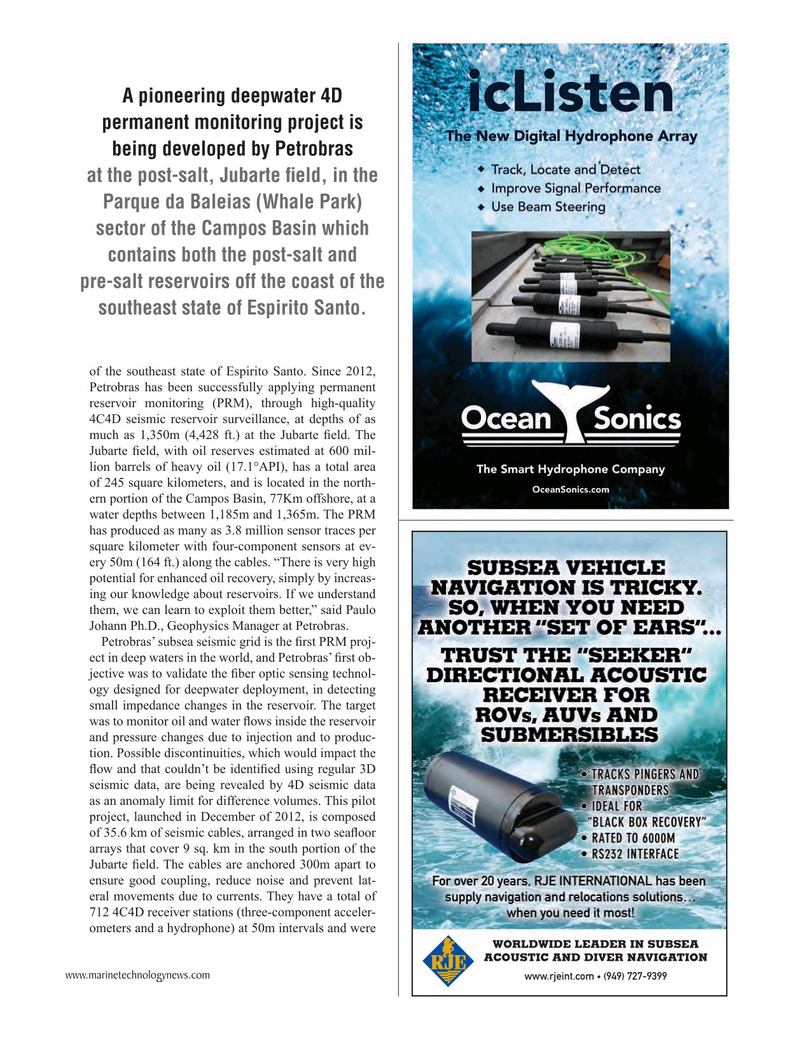
Page 53: of Marine Technology Magazine (March 2016)
Oceanographic Instrumentation: Measurement, Process & Analysis
Read this page in Pdf, Flash or Html5 edition of March 2016 Marine Technology Magazine
A pioneering deepwater 4D permanent monitoring project is being developed by Petrobras at the post-salt, Jubarte ? eld, in the
Parque da Baleias (Whale Park) sector of the Campos Basin which contains both the post-salt and pre-salt reservoirs off the coast of the southeast state of Espirito Santo. of the southeast state of Espirito Santo. Since 2012,
Petrobras has been successfully applying permanent reservoir monitoring (PRM), through high-quality 4C4D seismic reservoir surveillance, at depths of as much as 1,350m (4,428 ft.) at the Jubarte ? eld. The
Jubarte ? eld, with oil reserves estimated at 600 mil- lion barrels of heavy oil (17.1°API), has a total area of 245 square kilometers, and is located in the north- ern portion of the Campos Basin, 77Km offshore, at a water depths between 1,185m and 1,365m. The PRM has produced as many as 3.8 million sensor traces per square kilometer with four-component sensors at ev- ery 50m (164 ft.) along the cables. “There is very high potential for enhanced oil recovery, simply by increas- ing our knowledge about reservoirs. If we understand them, we can learn to exploit them better,” said Paulo
Johann Ph.D., Geophysics Manager at Petrobras.
Petrobras’ subsea seismic grid is the ? rst PRM proj- ect in deep waters in the world, and Petrobras’ ? rst ob- jective was to validate the ? ber optic sensing technol- ogy designed for deepwater deployment, in detecting small impedance changes in the reservoir. The target was to monitor oil and water ? ows inside the reservoir and pressure changes due to injection and to produc- tion. Possible discontinuities, which would impact the ? ow and that couldn’t be identi? ed using regular 3D seismic data, are being revealed by 4D seismic data as an anomaly limit for difference volumes. This pilot project, launched in December of 2012, is composed of 35.6 km of seismic cables, arranged in two sea? oor arrays that cover 9 sq. km in the south portion of the
Jubarte ? eld. The cables are anchored 300m apart to ensure good coupling, reduce noise and prevent lat- eral movements due to currents. They have a total of 712 4C4D receiver stations (three-component acceler- ometers and a hydrophone) at 50m intervals and were
WORLDWIDE LEADER IN SUBSEA
ACOUSTIC AND DIVER NAVIGATION www.marinetechnologynews.com www.rjeint.com (949) 727-9399•
MTR #2 (50-65).indd 53 2/22/2016 10:12:58 AM

 52
52

 54
54
